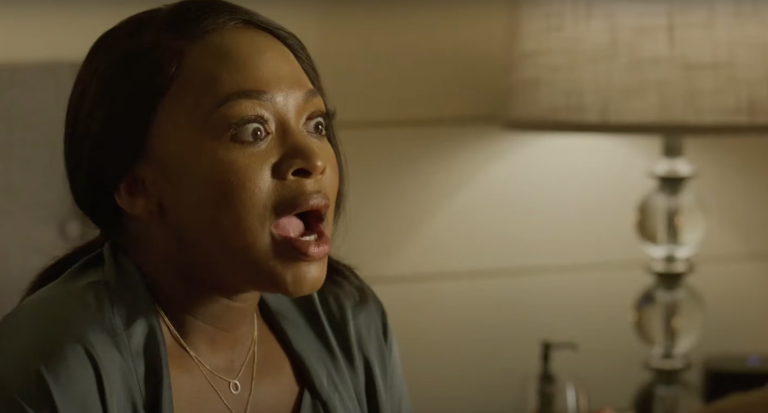Star Wars Visions (Season 2): Star Wars as an IP had been in dire straits before, with the quality of each consecutive story in media either falling down in quality or falling in viewership numbers. That’s not to say that storytellers are absent who can give a new perspective to Star Wars. After all, Star Wars as a franchise has always been looking at events from a certain point of view.
And none encapsulates that perspective more perfectly than the anthology series “Star Wars Visions,” where animation studios from all over the world would craft short stories set in the “Star Wars” ethos, but not necessarily in the “Star Wars canonical universe.” As a result, there are possibilities of interesting perspectives and different lenses without being constrained by the dreaded continuity of it all. It is not surprising that besides the Tony Gilroy-led “Andor,” Star Wars Visions is the most consistent show in the Star Wars stable in terms of quality, and this season is no exception.
Star Wars Visions (Season 2) Episode Recaps and Reviews
Episode 1 – Sith
From a plot perspective, it follows a force user who lives in a garage-like home space that is continually in flux, as the walls are always white. She is trying to fill up the walls with her paintings and paint her destiny in a way. But as she tries to color the walls, she finds the globules of color becoming blackish. Similarly, the top section of her home feels like it is in flux or developing, as El-Guiri Studios, the animation studio behind this appropriately titled short, shows that top section as completely darkened, with red lines slowly covering the walls.
It almost reminds you of Susnnah Clarke’s Piraneesi in that the world develops according to the characters present and inhabiting it. We are also given glimpses of the Sith Lord, whom we know as our protagonist, itself a remarkable character in aesthetics, be it her robotic hand or the white streaks in her hair, would finally face.
As she, along with her trusty droid E2, gets on the unicycle and drives towards the failing seventh beacon, she realizes that she is ambushed by three force users (assuming we are right). The world, so far completely covered in white, now becomes blood-red and orange as our protagonist faces off against her attackers and dispatches one of them while being chased.
She manages to shoot the Preatorian-guard-looking Sith down while riding her unicycle, but she is finally dislodged by the other. As she lies in pain, her droid E2 comes forward to protect her and shoots the second Sith dead by blowing its head off with the central canon coming out of the droid’s eye socket. But the droid is finally taken apart by the head Sith lord of the trio. As our protagonist finally enters her home, the Sith lord follows her, darkness enveloping the previously non-colored room.
The Sith Lord turns on his red flickering lightsaber, while our protagonist turns on her yellow curved one. As they fight, with the white and black colors around them colliding, we learn that our protagonist used to be this lord’s apprentice, and as he manages to overpower her finally, she realizes, by looking at her glowing red robotic hand, the balance of the darkness and the light, with the darkness literally a part of her painting for the painting to finally be complete.
With that revelation, she lights the red hilt on the opposite end of her lightsaber and moves swiftly, managing to finally kill him, as we realize as he fades away, proclaiming her to be the one true Sith master only. But as she proclaims to the dying specter and reiterates to her repaired droid as she flies away from the planet, she is no Sith anymore, but she is her own master, and she is capable of writing her destiny. The ship leaves the system as the camera moves out, and we see three planets suspended in space, resembling a blank white canvas.
Gorgeously animated, with force literally developing the world in colors or the world continually in flux as the protagonist faces off against her master, this is visual storytelling affecting the narrative storytelling literally and figuratively, producing an almost perfect juxtaposition.
Episode 2 – Screecher’s Reach
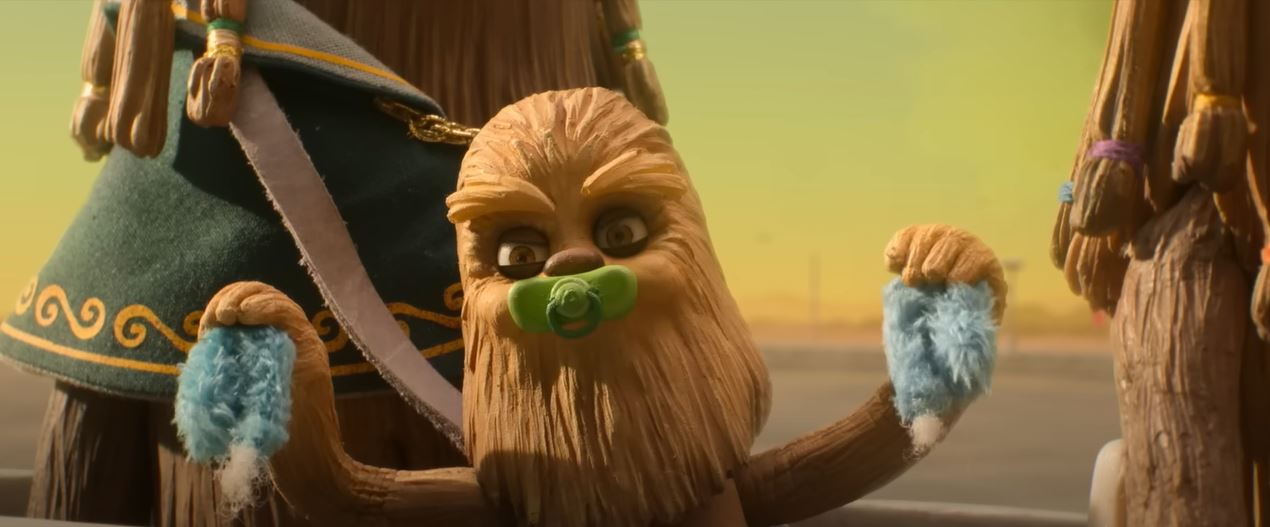
We open with the lights turning on, a dormitory full of alien workers waking up, the camera panning upwards as we see these alien and human workers working in what looks like a smelting factory. As we reach the topmost level, we see one of the workers responsible for the control of the steam valves getting frustrated as the wheel of that valve breaks.
We see the worker walk out as large drills are operating on the planet in the background, and the worker finally opens his helmet, revealing a young girl sighing. Her friends soon join her, and as they ask her why she isn’t working, Daal—we learn that’s her name—reveals that she wants to go to Screecher’s Reach and get out of there. As a third young purple alien joins the three friends, they agree to escape to Screecher’s Reach by stealing speeders, which they do.
We realize through their picturesque journey that the planet is partly an industrialized wasteland, and the part still left unchanged is a rural mountainous area, and as we learn from the myth of Screecher’s Reach in a literal campfire at night, the titular screecher is a ghost who lives in a dark cave at the center of a mountain, who has never been seen before but is the stuff of legends.
As the kids wonder what they would do to the monster, Daal’s dreams resemble those of a young Luke Skywalker or a young Cassian Andor in imagining a world better than what they have. The cave too, which they finally have to walk to because the speeders are unable to reach that far, resembles the force agglutination that had been present in Yoda’s swamp in Empire Strikes Back, in that the darkness was almost overwhelming as the horror almost attracted Daal in, his friends following and trying to catch up. But as the ghost finally reveals herself, a shapeless, almost formless, cloak-like being, Daal tries to escape. But the cave almost falls around them, separating her from her friends.
So far along the story, this had felt like almost an Irish folk tale set within a Star Wars landscape. However, as the ghost’s tendrils come close to touching her, we see her touching her pendant and repeating the mantra “It is all in my find” until suddenly it becomes very real when the “ghost” lights up a red lightsaber.
Her opening of the lightsaber unwittingly opens up a crack in the ceiling of the cave, which Daal rushes towards, narrowly missing the lightsaber thrown at her, which embeds in the cave wall, before being pulled back by the ghost. As Daal tries to climb up, a bony hand catches her and tries to pull her down. Daal tries to reach the top and suddenly realizes her latent force abilities when she controls the rock above her and pushes it down toward the ghost.
When Daal comes too, we see the light from the ceiling revealing the darkness gone, the rock having trapped the “ghost,” revealed to be a very old force user with a powerful scream ability. As the force user tries to pull her lightsaber, Daal jumps up and grabs it, and as she resists the pull and the scream, we watch in horror as Daal turns the lightsaber on.
The whispers fill the light of the dawn as Daal walks out of the mountain with the lightsaber. Her friends ask her if she is okay, and she can’t believe that the ghost is real. But her life is going to change, as we realize that the pendant she had been carrying with her is a transmitter, and she had been conversing with somebody this entire time, and now “it’s time for them to meet.”
To the shock and surprise of all the kids, they see a ship on the horizon, which soon lands, resembling the shape of a red diamond ensconced within a star. As the ship opens, we see a long-robed force user come down the stairs. We learn that Daal had been talking with this force user. The music turns foreboding when we realize that the force user had promised her a better life, and this lightsaber is now hers “because she did what she had to do.” As Daal asked for her friends to accompany her, we saw the force user refuse, and Daal looked back in tears at her friends and almost apologetically told them, “Don’t look back, right?”
Cartoon Saloon’s contribution begets a wonderful children’s horror story with hints of Star Wars iconography. Like all of Star Wars Visions’ short films, the basic tenets of the force remain the same, while the other attributes are reimagined according to the needs of the story. What elevates this story is the dark ending because it is made clear that Daal achieves her dream of wanting a “different” life. Whether it is better is definitely up for question because the force user praising Daal for her decisive choice in killing the “ghost” truly gives us an idea as to what Daal would ultimately become. The horror is not just in the aesthetics and the narrative; it’s also in the choice Daal makes in the end.
Episode 3 – In the Stars
Kochen and Tichina are the last of their kind in a polluted and dystopic world where fumes cover the starry nights. Tichina believes that she and her sister are force sensitive, as she tries to deflect a lone tie fighter but is stopped by her sister. We see them walk up to a magic stone that shows animated cave drawings once induced by a mysterious material called “starlight,” indigenous to that planet, ejected by the mushrooms, which could only bloom if the skies were clear, which is a rarity.
As Tichina blows the “starlight” into the stone, we see the story of the world, a grassy, clear, and beautiful one, until the Empire came and encroached upon their resources, taking over their water and resources and poisoning their land. Their mother, who was a powerful force user, led an uprising against the empire but was killed, and as the cave drawings show, they are now part of the “stars.”
Kochen, the older and more world-weary sister, gives her share of the water and plans to go on a routine run to steal more water from the hydraulic plant installed by the Empire. While in the middle of that run, as Kochen had managed to extract water from her backpack containing the canister, she saw the alarm go off and realized that Tichina had come to “beat them” instead of listening to her and staying hidden.
Managing to beat the security with her bo-staff, the two sisters manage to escape as stormtroopers keep firing at them. But as the two sisters are almost on the verge of escaping, Tichina refuses to, steadfast in her belief that her mom’s powers are alive within them and they can beat them. Tichina rushes towards the central reservoir of the plant and points her hand outstretched, willing the force to help her.
The head of that operation, surprised that any of “them” are still alive, instructs the stormtroopers to throw her aboard. Kochen rushes towards them, beating through the stormtroopers and security. As Tichina is thrown aboard, Kochen, the sister who refused to believe, finally harnesses the force within her and pulls her up. Now that both sisters are reunited, they join hands and are outstretched, damaging the pipes of the central reservoir, letting the water overflow, and destroying the whole factory.
When Tichina finally comes to, she finds herself in Kochen’s lap. The skies are clearer, and the plants and indigenous flora are slowly blossoming. And as Tichina exclaimed to her sister that she always knew that she could beat them, she pointed at the sacred rock, which was now illuminated with handprints where the starlight had been, with the “stars” revealing themselves even within the daylight.
Punkrobot Studios’ contribution is a masterclass in the intermixing of stop-motion and traditional 3D animation. The expressiveness of Tichina and Kochen is what highlights a mostly traditional adventure story with an important environmental message underneath. It is also fascinating how the force is shown manifesting in interesting and different ways throughout all the short films, with the “stars” in this case possibly corresponding to the existence of “force ghosts” in this version of the Star Wars universe.
It’s also interesting how both this and the previous short had imprisoned force users either escaping from the Empire’s encroachment establishments or standing against the encroachment establishments.
Episode 4 – I Am Your Mother
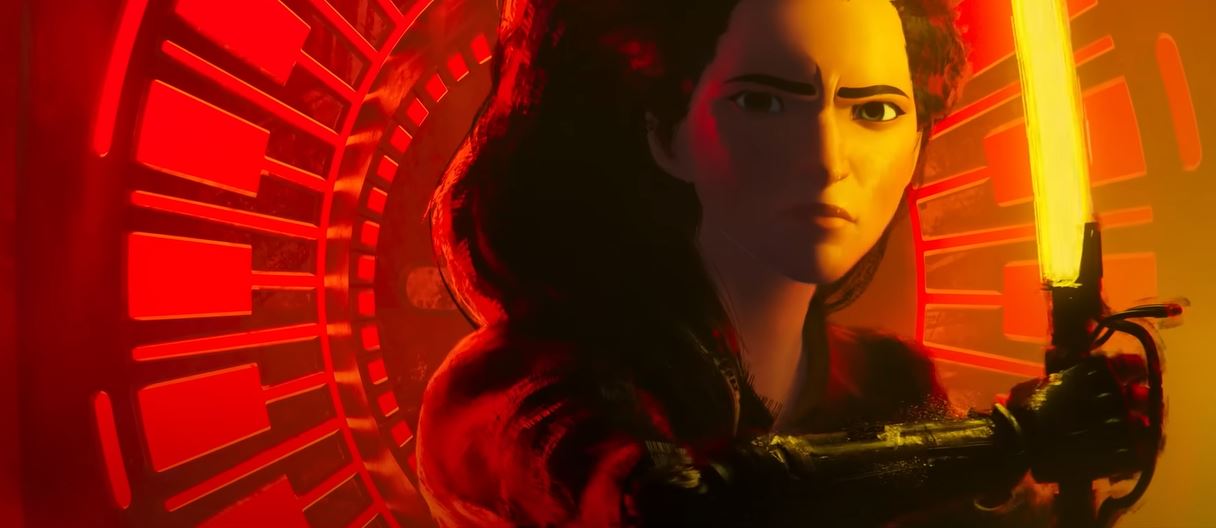
When the studio animating your short film is Aardman, the famous studio behind Wallace and Gromit and Shaun the Sheep, chances are that the short film will be light on the plot but heavy on light-hearted humor with simple but effective character moments. On a planet resembling Tatooine (it might resemble canon considering Wedge Antilles is in this), young Anni, a twi’lek, is embarrassed by her sweet but clingy mechanic mom and their old ship, which resembles a flying caravan. So when the flight academy where she is a student conducts a family race, she doesn’t tell her mother because of her embarrassment towards her mother and the “old junk” they call a ship.
As fate would have it, she flies her ship straight on the starting line anyway because Anni had forgotten to take her lunch. Nevertheless, now mother and daughter have to race together, especially when the bratty and snotty Van Peebles called their ship a “porta-potty” and “the cleanup crew.” Of course, the resultant race is a hilarious one, in which the mother and daughter finally reconcile over their feelings.
The daughter manages to show off her flying skills to her mother while simultaneously managing to defeat the Van Peebles by “drafting” below their ship and overtaking them using a maneuver called the “Ryloth roll.” Also, the Van Peebles’ laser resembles a miniature “Death Star,” which should raise red flags for everyone.
Aardman’s animation is almost comfort food in its old-school claymation aesthetic, which somehow goes well with the banged-up and lived-in depiction of this planet and this iteration of Star Wars. It is a simplistic tale told through a very British lens, which in a roundabout way does make sense, and like most of Aardman’s outputs, it knows exactly what it wants to be and executes it well.
Episode 5 – Journey to the Dark Head
We open with a rainy, cloudy sky-clad temple, the rain falling over a rocky courtyard. At the temple, one of the monks is instructed to look at the rocks, where the raindrops would coalesce and induce visions, which the rock holder would see. The student sees a hazy vision of a fight occurring between two individuals and a third onlooker standing in the middle between them. As the vision disappears from the rock, the head monk, who had been recording the vision verbatim, states that the student’s power hasn’t developed yet for clear scrying, and thus she would need to work on it.
The student, however, wants to do something more proactive, as she is concerned that these visions of an impending war, which they all witness, need to be shared with the Jedi, but her teacher refuses, believing that they must observe and not interfere. The student looks up at the clouds, towards the two statue heads hidden atop the clouds, and wonders loudly whether destroying the heads of the prophecies would stop the incoming darkness.
As time progresses, we see the student, named Ara, having grown up and now working as a mechanic on Coruscant. She requests the Jedi Council to go on a mission to destroy the statue heads, as that would act as a preemptive measure and impede the war before it even washes up on the Jedi’s shores. As one of the Jedis on the council eloquently states, “Crack the mirror so that the reflection changes.” While we understand that the council doesn’t take Ara’s statements seriously, they permitted this mission, provided that a Jedi Toul would accompany Ara.
We meet Toul, a young Jedi meditating with his trainer, but his mind is troubled. He is remembering the last lightsaber duel he had with a Sith lord named Bianchi, who had managed to kill his previous master without much of a hassle by using a whip-like instrument and driving it through her heart. Bianchi leaves him alive, having seen the rage and darkness in Toul and developing a keen interest, leaving a scar on his lips as a souvenir.
Back to the present, Toul’s trainer tries to advise him to keep control of his anger, but Toul is called away on a mission, which we learn is to accompany Ara to the temple. Ara is surprised at the “little kid” they sent for a Jedi and even more surprised at his attitude, which she finds very antithetical to the Jedi she had grown up listening to. Toul, meanwhile, believes this mission to be a waste of time and wonders what he is even doing here, to which Ara replies smartly that she doesn’t know either because the council decided to send him, not her.
Ara is nothing if not prepared, so she stops by the marketplace on the planet to buy some gear for climbing. At the market, as soon as they are flying towards the temple, Toul starts to feel a familiar presence, and his premonition is proven correct when Bichan’s ship attacks them. As Bichan is curious about Toul’s presence and prepares to destroy their ship, Ara and Toul drive out of the ship, hitting Bichan’s ship with a speeder.
That collision damages the speeder, which Ara realizes will not survive the trip. But that is beyond help, as Bichan managed to survive that collision and jump atop the speeder, leading to a fierce lightsaber duel on top of the speeder. As Ara increases the speed and pilots the speeder above the clouds, Toul pushes Ara with the help of the force towards the stage connecting the two statue heads, which she manages to catch on to because of the gloves she had bought for climbing. As she begins to run towards the dark head, she realizes that the stage is lighting up as the light and dark energies are intermingling because the two force users have now shifted their fierce battle on the stage.
Bichan tries to seduce Toul towards the dark side, trying to make him understand that the power he can harness through his rage would be a sight to behold. As Ara shoots the bombs towards the dark head, the dark clouds part ways, sunlight seeps through, and Ara sees both the statue heads intermingling with the light and dark heads.
She looks back and suddenly sees Toul being wrapped around the neck by the whip-like weapon of Bichan, having lost his lightsaber while distracted. That immediately reminds Ara of the vision she had seen on the rocks, realizing that she was the third onlooker. Finally realizing what she has to do, she controls and pilots her bombs and detonates them in the sky. The shockwave almost blinds Toul and Bichan. Toul, who was hanging from the stage, pulls his lightsaber with the help of the force and cuts Bichan’s head off, killing him. Then Toul is in freefall, looking up as the statue heads. He then sees Ara falling towards him, barely managing to catch him and pull the parachute up, landing at the rock courtyard where Ara had seen the visions so many years earlier.
As Ara tries to apologize to Toul for effectively “wasting his time” and understanding it didn’t make a difference, Toul agrees with her but also believes that the light and the dark need to co-exist for the overall existence to persist, and if another evil rises, a light side should rise to meet it. Thus, he agrees that they both needed this mission to set their priorities straight. Now they must find a new ship to continue this fight against the Sith.
“Journey to the Head” takes the ethos of Star Wars, the dichotomy of the light and dark sides, and adds a healthy dose of wuxia and Eastern philosophy within its storytelling. The result is a complete story like the first short, which feels part of an already-established universe we wouldn’t mind returning to.
The world-building is meticulously done, and the designs of the characters resemble the Star Wars aesthetic but are still distinctive enough in their own right, but it is Studio Mir’s animations that truly do the trick, crafting gorgeous and dynamic action set-pieces, giving the entire story a poetic yet exciting encapsulation.
Related to Star Wars Visions Season 2: David Tennant’s Star Wars Return Confirmed
Episode 6 – The Spy Dancer
It begins like any noir movie or espionage thriller of the 1940s: stormtroopers, muddied and harried from all the brutality they show innocent civilians, enter a club to wind down. The club’s specialty is the central performance by Loi’e, a billowy dancer who looks human, except that she has two small horns protruding from her forehead, and she has heterochromia.
We also learn as she prepares herself to go out for her performance that she has been a spy for the rebellion, managing to plant trackers on the stormtroopers so that their actions could be tracked by the rebellion and information delivered to them. She prepares for her performance by talking with her handler and getting her final set of trackers. This is her last mission, whether she had it planned or not.
As her performance begins, we learn Studio La Chette’s specialty: fluidity in linework within animation. A form of watercolor-like formation gives rise to a different sort of dynamism and movement as we see Loi’e traverse the full length and breadth of the club, almost gliding with the help of her cloak and surreptitiously managing to plant trackers, until suddenly she sees an imperial officer with a “K-2SO” resembling a droid sitting on one of the top opera seats.
Her memory flashes back to her time in her village, ravaged by the empire, an imperial officer snatching her infant away from her and knocking her unconscious. This little act of distraction almost causes her to fall to her death. But her assistant jumps backstage to catch her, and both of them land gracefully. The stormtroopers are none the wiser, thinking that was all part of the performance. However, Loi’e is shaken, and almost immediately, she alerts her assistants to escape through the hidden tunnels, asking her handler to prepare their ship. As the handler and even her chief assistant wonder what has shaken her, she prepares herself to do one last thing.
She begins her performance again, except this time she glides herself towards where the Imperial officer is sitting and protrudes a sharp spike from her bracelet to kill him, only to stop as she sees him and realizes this isn’t the same Imperial officer. That hesitation is enough because the Imperial officer orders the stormtroopers to attack.
A fierce battle ensues, with Loi’e managing to evade and also attack the stormtroopers with her litheness and agility, her spiked bracelets strong enough to deflect the blaster fire. She is also surreptitiously helped by her assistant, who comes back to help her instead of listening to her and escaping. Loi’e uses her cloak to wrap the imperial officer in a chokehold and climbs to the top of the domed ceiling of the club.
As the imperial officer asks why she is after him, Loi’e reveals that this imperial officer is her son, who is hiding his true nature by wearing a hat as well as an eyepatch. Her cloak had been hanging below, which the droid started pulling, almost dragging Loi’e down, but her assistant managed to jump down and completely wrap the droid in the seams of her cloak and destroy it. Loi’e finally goes to her “son” and hugs him, proclaiming that the empire has taken everything from her.
They separate as an imperial ship with more stormtroopers flies up to escort the imperial officer to safety, while Loi’e rushes towards their ship and barely manages to jump aboard as they escape the planetary system. As the handler congratulates them for putting on a good show, Loi’e reveals that her son is alive, and now she has a way back to him, revealing that she had given his large gold pendant to him.
Back on the star destroyer, we see the Imperial officer open the pendant to see a hologram of a baby with heterochromatic eyes and horns. He removes his hat to reveal two incisions where the horns used to be. As he closes the pendant, we see a tracker embedded at the back of it, unbeknownst to him.
Studio LaChette manages to bring its own unique, albeit a bit exaggerated, stylization to a pretty well-done espionage thriller. The action set-pieces are just gorgeous and dynamically picturized, but as with most of these shorts, the emotional kicker usually comes towards the end. With most of these short films in this season, the effects of the Empire are far more explored, if not the Sith overall. The film leaves itself open for a continuation, which I wouldn’t mind going back to.
Episode 7 – The Bandits of Golak
As an IP, Star Wars is so inherently American and European that it was hard even to contextualize it from an Indian perspective. Considering that we as a country have epics of our own with our heroes and our larger-than-life villains, we didn’t exactly need a Darth Vader or the hero’s journey of Luke Skywalker.
The seventh episode of this season of Star Wars Visions, titled “The Bandits of Golak,” is exquisite, not only because we have an Indian Jedi and an Indian Inquisitor, but because we have the first glimpse of an Indian version of what Star Wars could look like. It is exquisite in its intermixing of imagination with some real imagery of history and colonialism.
The train in which the brother-sister duo of Rani and Charuk are traveling is a perfect intermingling of stuffy and colorful, with just the slightest bit of modernity and, of course, otherworldliness. It resembles a sleeper class compartment, but the majority of the passengers are a mix of humans, stormtroopers, and aliens.
The regalia of Charuk and Rani resemble traditional Rajasthani clothing. As Rani tries to alleviate her sadness by buying some sweets from the alien hawker, Charuk goes off to buy them. We see Rani use her force ability to pull the flute from Charuk’s bag and start playing, which entices one of the passengers to inform the stormtroopers.
Charuk tries to distract them by stealing a bag of sweets and trying to climb on top of the train as the train, driven by Indian members of the Empire, passes through “insurgent” territory. We see stormtroopers with their speeders surrounding the train as they try to instruct Charuk to dismount. Then horseback insurgent troops surround the train and begin attacking the stormtroopers, which Charuk realizes are the rebels.
He is confused, though, about so much hoopla for a pack of sweets, not realizing that Rani’s forceful use is what has caused this alarm to exacerbate. As the train finally begins to enter a tunnel, Rani runs, looking upward, following Charuk. She finally managed to open the glass ceiling and let him jump in. As the train goes into the tunnel, we see a statue of a royal king carved into the mountain, but with a lightsaber instead of a sword.
Charuk and Rani, as they finally reach their stop, walk up to what looks like a traditional Rajasthani dhaba, except the banner is written in “Basic.” The customers are a mix of aliens and humans, with the owner of the dhaba being an old woman named Parul, who warns them of an impending storm and urges them to eat quickly and be on their way.
Rani, while still shaken from the ordeal, is happy that her beloved sweets are still available to be gorged. As she uses her force power to lift the bowl containing the sweets, Charuk warns her to put it down, but she is unable to control it, and it hits the slovenly large alien, who again hits his smaller companion because his one glassy eye couldn’t notice the direction of the attack.
But someone did because we see a silky voice cut through the noise and lively folk music of the dhaba. We see this world’s version of an Inquisitor, who looks like a cross between the Inquisitors of Star Wars with the British officer regalia, the black suits adorned with golden streaks at each of the pouches. His hand contains the usual spinning lightsaber of an inquisitor. As the inquisitor pulls Charuk towards him for questioning, Charuk warns Rani to stop lifting all of the bowls from all the tables, but she informs him that it is not her doing.
Within minutes, we see all the plates attacking and being thrown at the inquisitor, the stormtroopers, and the customers. A dust storm rises, and as the inquisitor readies himself to deliver the final blow, he is stopped by old lady Parul, who reveals her cane to be a dual lightsaber. The surprise of the inquisitor in seeing a Jedi at Golak is only matched by the speed and dexterity with which Parul manages to attack and finally beat the inquisitor by delivering a killing blow to his neck.
Parul doesn’t waste any time and uses her force ability to shift the waters of her Turkish bath, revealing a hidden compartment with the rebel insignia. She reveals to Charuk and Rani that there are other force users hidden here, just like Rani, and this is the only way Rani could remain safe from the clutches of the Empire.
But as with Screecher’s Reach, when Daal could not have her friends be with her on the long journey to follow, Rani had to face it alone. Rani hugs her brother Charuk, promising that they would meet again one day. Charuk reiterates that her father always knew that Rani was meant for greater things, which is why her father had told them of this location to escape once their village had been plundered by stormtroopers, quite possibly because of Rani being force sensitive.
As Rani walks into the tunnel and the panel closes, the water covers the Turkish bath, and bubbles suddenly appear over the surface before Rani’s flute floats up to Charuk, a final gift from Rani to her brother to remember her.
88 Pictures takes the concept of the Empire being the representation of the colonialists and transplants it. It is not a coincidence that elements of the officers of the Empire and even the Inquisitors resemble British officers in India under British rule. What stands out here are the details because “Star Wars in Indian Context” can’t just afford to be unique; it needs to be tangible. The world that director Ishan Shukla sends the viewers into is so a reflection of real history. Yet so intrinsically a part of Star Wars that you can’t help but be swept up in the grandeur, the score, and the overall verisimilitude of it all.
It is only bolstered by the strong voice acting, and again, it is so fascinating how the force users being trained as kids are taken as important linchpins throughout the best of these short stories, either to be hidden or to be molded. It’s a fascinating and yet haunting and also terrifying prospect, which again hearkens back to Lucas’ original ideas about the Star Wars Prequels—a series that had been strong on interesting ideas but had the weakest of executions. Not so much here. The ethos of Star Wars is intact, but this is the world I want to explore the most in a movie.
Episode 8 – The Pit
From a canonical perspective, this episode might be the single most important episode in all of Star Wars Visions because Studio Shai’tjo has animated this short film in conjunction with Lucasfilm, which is notable, especially Lucasfilm’s involvement. The story, too, definitely feels canonically relevant and, as a premise, important and haunting. It begins with the empire instructing a couple of slaves to start digging at a specific spot on a desert planet. As the slaves start to dig, one of the slaves hits upon a diamond-like metal, which the stormtrooper orders a droid to bring to him.
As the slaves realize it’s a kyber crystal, we too realize that what we are going to watch is a canon revelation: how kyber crystals are mined, and the results are horrifying. We see the slaves digging deeper and deeper, and above ground, a city is being constructed with the help of the Kyber crystals. When the hole has become large enough that it feels like a twelve-foot-deep pit, they finally hit upon the core, which bends their pickaxe.
That is the signal for the stormtroopers as they finally cease all operations. But for the stormtroopers and the empire, that means getting out of dodge without letting these workers out of the pit. Thus, the workers are trapped in the pit with nowhere to go.
A young worker named Crux plans to climb out of the pit and inform the inhabitants of the nearby city to ask for help because, as he explains to little Vily, everyone has an inner light, and they should believe and follow that light. Amidst the grumblings, the workers all agree. The next morning, we see Crux climbing up the walls of the pit, with the armadillos within the walls digging holes for Crux to latch on to and get up to the surface.
Finally getting up, he rushes to the city, which is almost blinding due to the glare of the kyber crystal at the top of the building in the city center. He finally stands up on the raised platform in the city center. Crux urges the inhabitants of the city about their plight, how this kyber crystal powering their city hadn’t been mined by the empire but by the same workers who are currently trapped within the pit. Eventually, he is found out by two stormtroopers, whom he tries to escape from, but they shoot him unconscious with blaster fire.
Dragging him in the rain, they drop him into the pit. As Vily comes out of her tent, she sees a group of people huddled around her. She pushes through them and finally sees Crux’s body. With sorrow, she remembers Crux’s advice and tells her mother to ensure everyone knows “to follow the light.”
So that’s what all the workers do: scream out through the pit, through the storm, “to follow the light,” such that the inhabitants of the city finally come to the edge of the pit with lights and pitchforks, the stormtroopers powerless to stop them. The episode could have ended bleakly because it showed all the people walking away from the pit. But then we see a light source illuminating the pit as a ship finally lands to escort the workers out of the pit.
The ship finally leaves the pit, with the workers seeing sunlight after a very long time, and as Vily searches in her pocket, she sees the kyber crystal that Crux had given them. Surprisingly, we see her exhibiting her force abilities unwittingly as the crystal stands up perpendicularly and blue energy starts swirling through.
There is also a post-credits scene where we see a painting of Vily and Crux rising up against the empire, definitely giving off punk-rock vibes. It also hearkens back to the paintings Sabine made in Star Wars: Rebels.
“The Pit” feels definitely like an episode answering a canonical question about Kyber crystal and doubling down on the fascistic undertones of the Empire. The story, too, feels very much like the voice of a revolution rising against the empire. From a premise standpoint, this is a slam dunk. From an execution perspective, the short film falls flat, both from an emotional and a plot perspective. It is still well done, just not as well as the rest of the episodes throughout the season.
Episode 9 – Aau’s Song
Imagine if the Shire was an entire planet in the Star Wars galaxy. That is the world we find ourselves in in “Aau’s Song,” beautifully animated by Triggerfish Studios, where each character looks like a 3D rendition of a woolen soft toy. In this world, the Kyber crystals had been corrupted by the Sith, but miners would seek the help of the Jedi to rid the mined Kyber crystals of corruption so that they could be utilized or sold across the galaxy.
One such miner is Aau’s father, Abi, whose day becomes infinitely busier when Aau sees a ship coming and realizes that a Jedi has come to visit her father. Aau also has a wish that she can’t fulfill because of the calamitous effects it has on the world at large. She wants to sing, but her melodious voice causes tremors and unforeseen reactions among the Kyber crystals. When Aau sneaks in to look at the Jedi who had come to visit her father, even then, the crystal misbehaves. Her father thus wants to protect her and sternly forbids her to sing.
When her father travels to work with her, where he goes off to the hills to mine for corrupted kyber while she washes off lice for the animals, she can still feel the kyber crystals, as if they are calling out to her. Finally deciding to follow those voices, she climbs up the hills courageously without any ounce of fear. However, when she finally goes to enter the cave from where she can hear the voices, she sees her father.
She then sneaks back, barely managing to squeak, but is distracted by hearing the voice from somewhere below her. Raising her arms outstretched as if to call the voice to her, she almost slips and falls, barely managing to break her fall, before finding another entrance to the mine. Sneaking in, she finds herself at the center of the mines, surrounded by the red, corrupted kyber crystals, and as they all start calling out to her, she starts to resonate like a tuning fork and starts singing.
Her father suddenly finds her and barely manages to drag her out of the cave, but it’s too late, as cracks around the mountain have begun to form. The hanging bridge that they had crossed to get there suddenly falls, with Abi hanging on to it for dear life. Aau tries to hold on, but the pole gives way, and as Abi and Aau both fall, we see the Jedi using her lightsaber to scale the mountain, slowing her descent, landing below them, and using force to slow their fall.
As Abi and Aau both catch their breath, the Jedi asks whether they are ready to run. Aau, finally having an epiphany, reassures her father, opens the apron covering her face, and vocalizes melodiously. Her harmonics hit all the kyber crystals, which suddenly turned bright blue as all the corruption within them withered away. The Jedi explains to a stunned Abi that her voice is a gift that can cure Kyber crystals naturally, but this is a gift that should be harnessed, and for that, she must come with her. Abi argues, saying that her life is here, but the Jedi counter-argues, saying that no one can ignore their calling.
We see Aau and Abi enjoying a last meal together before Abi hugs Aau, reminding her she is the first of her kind to go to the stars. As Aau walks up to the ship to possibly go to the Jedi academy to train, we see the ship finally leave the shire-like planet, with the kyber crystals blinking in cerulean blue.
Triggerfish Studios crafts a lovely folklorish tale about a siren song, interestingly intermixing it into the Star Wars mythos. The animation is very different, reminding you of the Wes Anderson movies “Isle of Dogs” and “Fantastic Mister Fox” in their symmetry and their tangibility. But there is also a sense of comfort in watching this animated film, which more closely resembles the Aardman animated episode “I am your mother,” which is again about the relationship between children and their parents.
I did like how the darkness here is an abstract concept, something just out of reach, but the corruption of the Kyber gives it the form of the forbidden fruit in its seduction. It’s a very different and very beautifully animated movie, with a hearty amount of soul and a subtle amount of melancholy within it.
Also, Read – 45 Years Later: Star Wars Holiday Special (1978)
Star Wars Visions (Season 2) Themes Explained
The Innocence and hope inherent in Children
A recurring theme through “Screechers Reach,” “In the Stars,” “I am your mother,” “The Bandits of Golak,” “The Pit,” and “Aau’s Song” is the innocence of children. “I am your mother” is the most lighthearted of the lot, an Aardman Wallace and Gromit type of story set within a Star Wars-resembling universe. Even then, there is an overwhelming innocence in that offbeat sense of humor.
“Screecher’s Reach” and “In the Stars” are all about the hope of children to search for a better world and escape from the dystopia in their world. But choices in the Star Wars universe lead to different roads. For Daal in “Screecher’s Reach,” it leads to a foreboding one. For Tichana in “In the Stars,” it leads to them freeing their world from the Empire’s chokehold.
“Aau’s Song” delves into the innocence of a child and her wish fulfillment and how the fulfillment of that wish ultimately proves to be the solution. A similar form of hope imparted to a small child leads to the solution in “The Pit,” however hackneyed it might seem.
More foreboding, though, is how it is the ethos of Star Wars that children are finally separated from their home or their family to learn about the force or any of their supernatural abilities. It always leads to heartbreak or resignation. On the one hand, it is a child’s natural state to take his first step into the larger world. On the other hand, Jedi or Sith, these kids being so young and not allowed to see their parents for their safety, the question of fairness and justice in the world does arise.
The Balance of the Light and the Dark Side
Arguably, two of the best short films in this collection – “Sith” and “A Journey to the Dark Head” are all about how the light and the dark side need to co-exist for existence even to be persistent. “Sith” literally proves that, with the narrative relying on the visual color palette to ensure that light and dark co-exist. “Journey to the Dark Head” proves that the entire mission to destroy the said “dark statue head” would not only break canonicity from a storytelling standpoint, but the battle between Bichan and Toul also showed the intermingling of the light and dark, thus rendering any of the statue heads being called representations of the “light” or the “dark” ultimately a moot point.
The Chokehold of the Empire
It is even more fascinating how this season dealt more with the Empire as the organization, as the fascistic force acting as the chokehold, responsible for breaking up families and even destroying worlds and indirectly forcing away their inhabitants to the dark side (“Screecher’s Reach”). “In the Stars” is entirely about how the presence of the empire completely eroded a planet’s resources and also ensured that the indigenous population of that planet had been completely eradicated.
“The Spy Dancer” is an espionage story operating within the battle between the empire and the rebel alliance while also acting as a stealth reunion between a mother and her lost son, who an Empire official had kidnaped while her village had been burned and plundered.
“The Pit,” the most canonical story of the lot, is literally about how the empire uses “slave labor” to mine kyber crystals, which are used as fuel for energy blasters as well as the key material for the Jedi lightsabers. Moreover, as shown in that short film, it literally powers an entire city, while the Empire would rather the labor rot in the pit and remain forgotten.
“The Bandits of Golak” is the most “Star Wars” soup of all the short films, having a little bit of every element within it, but even here, we see the Empire being a definite presence, and since the tone is decidedly Indian, comparison with the Empire and the British Empire’s rule over India isn’t a hard comparison to make at all, especially with the design aesthetics.
Star Wars Visions (Season 2) Final Thoughts
At the end of the day, “Star Wars Visions” is about the recontextualization of the mythology of Star Wars through different cultural lenses and different animation styles. Sometimes the recontextualization swings so hard that it is decidedly perfect (“The Bandits of Golak”); other times, the recontextualization shifts completely in the other direction and becomes almost trivial (“I am your mother”). It is also not a coincidence that one of the weaker stories in this whole collection is the one that adheres most closely to canon (“The Pit”).
From the perspective of uniqueness, Star Wars Visions does its job almost spectacularly well because even within all of the sheen, all of the folkloric stories of the different regions remixed within these collections, the philosophies strengthened or diminished, the mainline ethos of Star Wars remains intact. It might be argued that Star Wars Visions, even with all of its deviations, is more faithful to the ethos of Star Wars than most canon stories out there, and honestly, that should grab everyone’s attention.

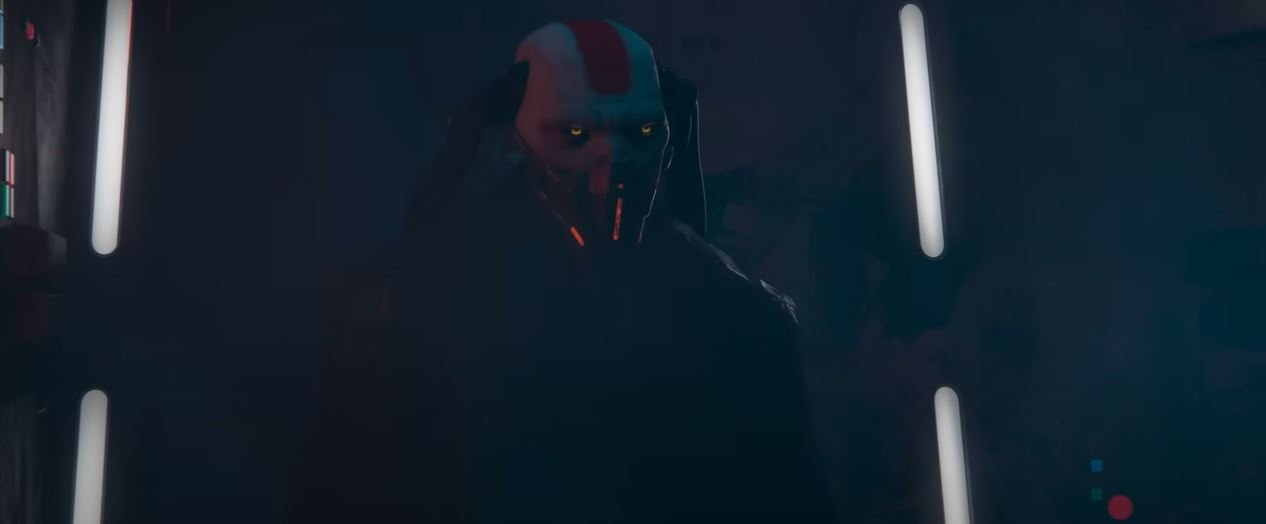
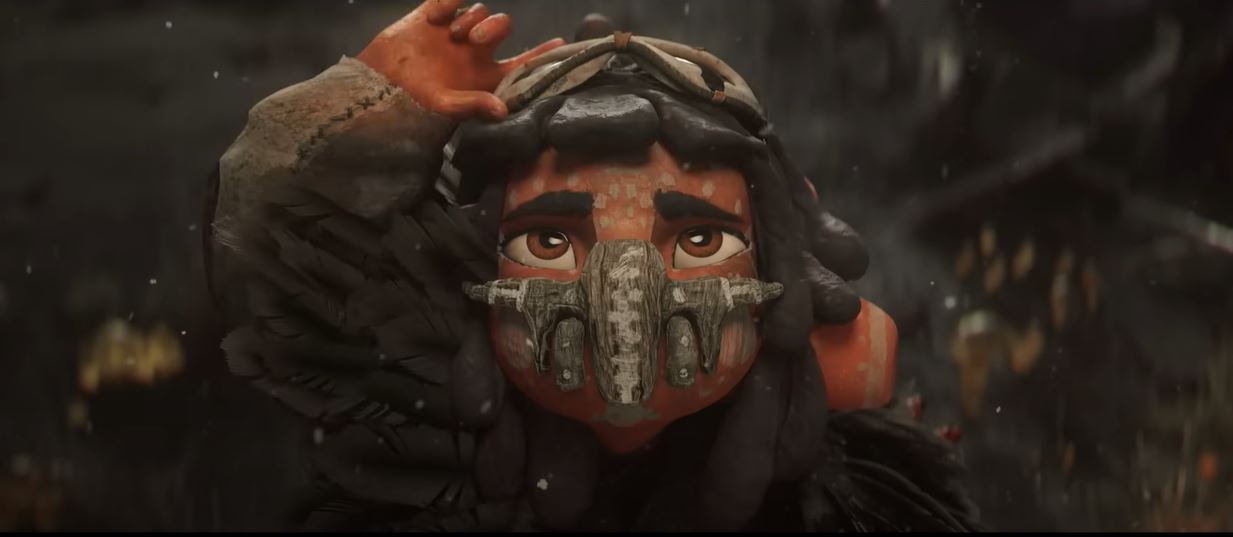
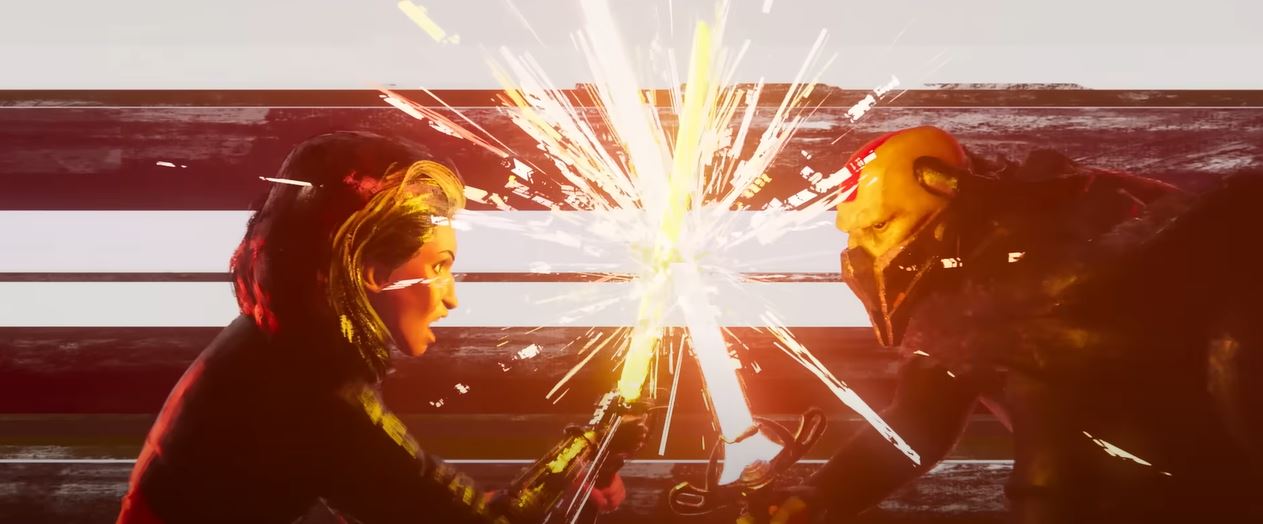
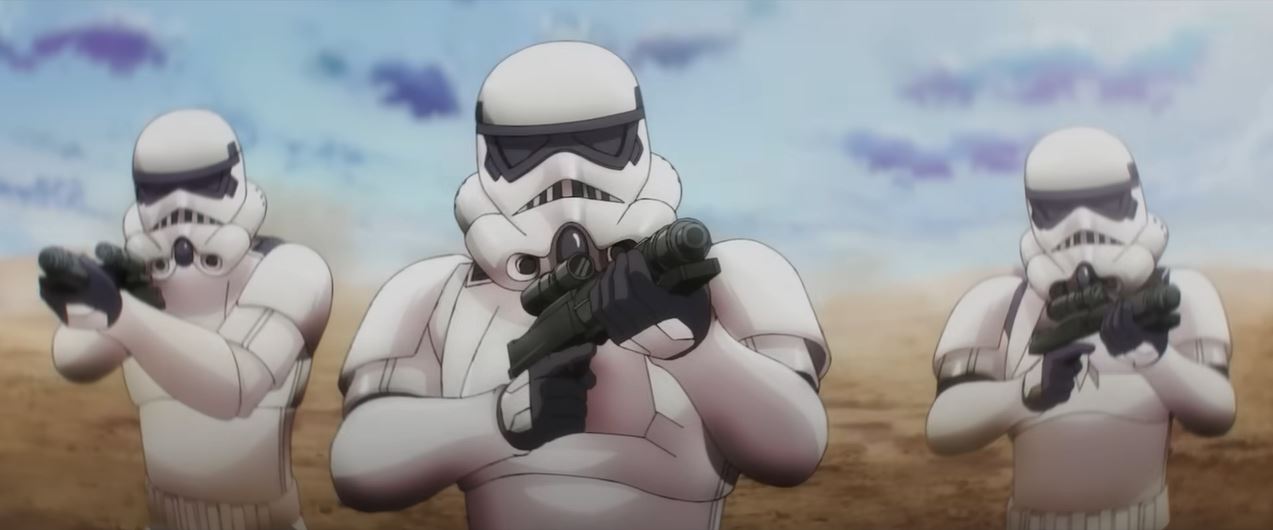





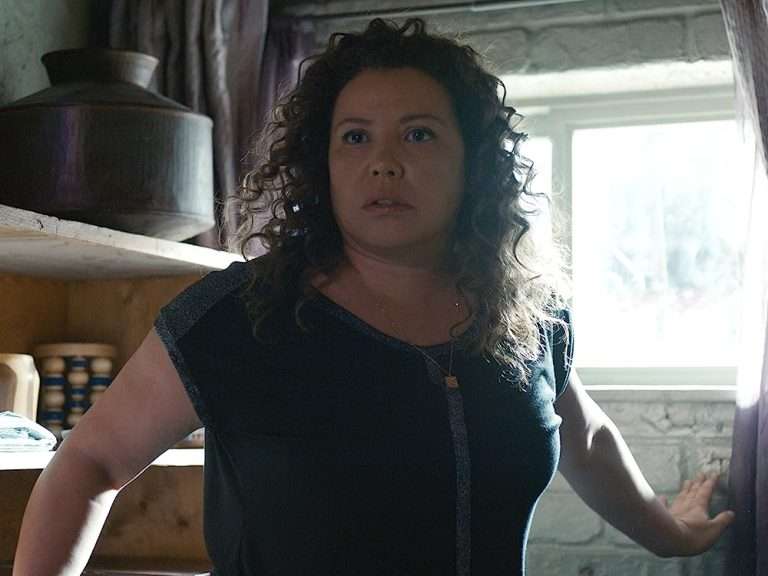
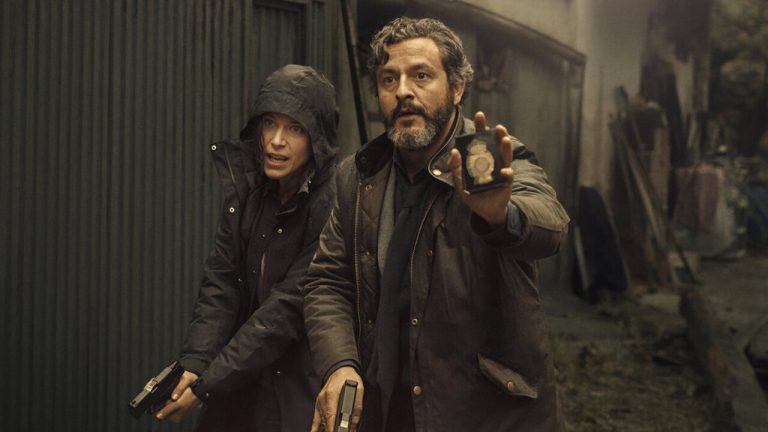
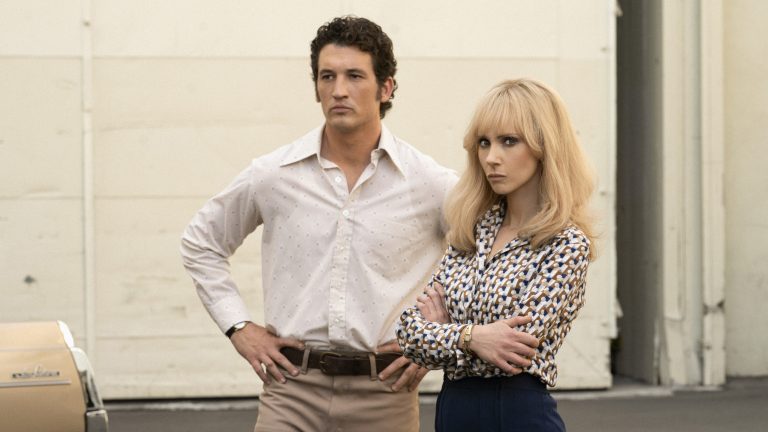
![The Brand New Testament [2015]: “Divine Intervention”](https://79468c92.delivery.rocketcdn.me/wp-content/uploads/2016/03/The-Brand-New-Testament-3-768x467.jpg)
